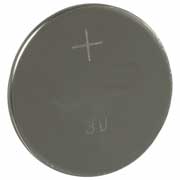
MONDAY, May 14 (HealthDay News) — Cases of children rushed to the emergency room after accidentally swallowing coin-sized batteries found in many household gadgets have doubled over the past two decades, new research reveals.
Serious complications — including fatalities — can arise when so-called “button batteries,” found in items ranging from remote-control devices to children’s toys, get lodged in the esophagus.
“The increase we’re seeing is a call to action,” said study lead author Dr. Gary A. Smith, director of the Center for Injury Research and Policy at Nationwide Children’s Hospital in Columbus, Ohio. “I’ve treated many of these children, and when it happens it’s absolutely horrifying. So while we’ve always respected the dangers these batteries pose, now it’s really time for us to redouble our efforts to warn parents and work with manufacturers to take steps against this risk.”
The study appears online May 14 and in the June issue of Pediatrics.
The authors looked at U.S. National Electronic Injury Surveillance System data concerning all battery-related visits to the ER among children up to age 18.
The data covered the years between 1990 and 2009, and though ER visits related to all types of batteries were tracked, the team noted that nearly 84 percent of such visits involved button-sized batteries.
Four different types of accidental contact with button batteries were tallied: swallowing and insertion of a battery into the mouth, ear, or nose.
The team found that over the 20-year period such contacts translated into nearly 66,000 ER visits, with a dramatic increase over the final eight years. Button batteries accounted for 2,785 ER visits by kids younger than 18 in 2009, up from 1,301 in 1990.
“In effect, the curve of ER cases is now swinging way up,” Smith said, “which means the increase is increasing, so to speak. And this coincides with another very important factor, which is that when they are swallowed the risk is greater than ever because of the relatively recent introduction of 3-volt 20 mm lithium batteries. Button batteries used to be just 1.5 volts, so that means that these new batteries are much more powerful than their predecessors.”
That means that although 92 percent of battery cases are successfully treated, the remainder face an ever-increasing risk for severe internal damage, Smith said. “When these increasingly powerful batteries stop in one spot in the esophagus they can create a little micro-current and burn a hole right through, causing very serious damage in less than two hours,” he explained. “It can even burn into the aorta and cause a child to bleed to death.”
Toddlers and others 5 years and younger faced the highest risk for accidental button-battery contact, with the average age of incoming ER patients just below 4 years.
Boys accounted for a bigger slice of the ER visits (about 60 percent), while most cases (nearly 77 percent) were the result of battery swallowing. Nose contact accounted for roughly 10 percent of cases, followed by mouth exposure (7.5 percent) and ear insertion (almost 6 percent).
“For parents, the message is that if they suspect that their child has swallowed a battery they need to get to the ER right away,” Smith said. “And in terms of prevention, they need to store and dispose of batteries out of reach, and also tape all battery compartments shut.”
“For manufacturers, what we really need is to have an overarching effort by the industry to make battery compartments inaccessible and child-resistant.,” Smith added. “For all products. Not just toys. Because most were not coming from products intended for children. They were coming from remote controls. Flashlights.”
Dr. Lee Sanders, an associate professor of pediatrics at Stanford University in Palo Alto, Calif., also expressed concern.
“Whenever we see a marked rise in any cause of injury for a child, it’s concerning from a public-health standpoint,” he said. “So we need to investigate the root cause of this doubling. One possibility is that there is, in fact, increased exposure to button batteries themselves. But of course we might have to also look at other causes, like changes in the actual reporting of cases that might have taken place as the system for reporting improves or the coding for reporting improves.”
Sanders added that parents should heed the general advice regarding choking, especially for those 5 years and younger. “Children should never be unattended and they should never be within reach of any object that can fit through a choke tube, which is basically the cardboard tube of a toilet-paper roll,” he said. This is particularly the case with objects not normally considered dangerous, such as children’s toys that have batteries and other small parts, and various objects found in the kitchen or bathroom. “That’s the best preventive strategy,” he said.
More information
For more on button batteries, visit the U.S. National Library of Medicine.

